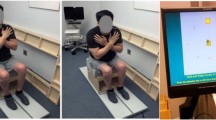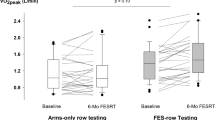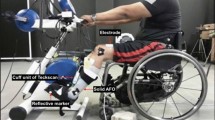Abstract
Study design:
Single-subject (male, 64 years of age) case.
Objectives:
To determine the feasibility of a home-based FES-LEC (functional electrical stimulation lower extremities cycling) program and effects on body composition, quality of life (QOL) and seat pressure mapping in an older individual with spinal cord injured (SCI).
Setting:
Home-based FES-LEC with internet connection. Southeastern United States.
Methods:
FES-LEC three sessions per week for 9 weeks in the participant's home and monitored by the research staff via internet connection. Pre- and post-exercise program testing of seat pressure mapping, QOL and body composition including percent body fat (%BF), fat mass (FM), lean mass (LM) and bone mineral density (BMD).
Results:
The participant completed 25 of 27 recommended exercise sessions over 9 weeks for a 93% compliance rate. Cycling distance increased from 3.98 to 9.00 km (126%). Total body LM increased from 48.94 to 53.02 kg (8.3%). The %BF decreased from 29.6 to 28.4(−1.2%). Total body weight, FM and BMD remained unchanged. Average static seat pressure decreased from 55.5 to 52.59 mm Hg (5%), whereas maximum seat pressure decreased from 120.76 to 91.5 mm Hg (24%). The psychological domain (perception of body image, appearance and self-esteem) of the QOL questionnaire improved from 12.67 to 14.
Conclusion:
Positive changes in this study regarding body composition, QOL and seat pressure mapping support results of clinical studies using FES-LEC training on younger adults with SCI. The high percentage of exercise adherence and positive results on body composition, QOL and seat pressure provide support for the feasibility of home-based FES-LEC.
Similar content being viewed by others
Introduction
Only 31% of able-bodied (AB) older adults report participating in 20 min of moderate physical activity three or more times per week whereas the activity level of the spinal cord injured (SCI) population is <40% of the sedentary AB population.1 Add in the factor of a markedly increased life span (currently nearing that of people without SCI)2 and it is no wonder that the primary causes of death are no longer complications related to SCI but rather conditions associated with age and inactivity. Cardiovascular disease is now the foremost cause of death of persons with SCI over 60 years of age3 and obesity, metabolic syndrome and osteoporosis are considered epidemic in the SCI population.4 It is clear that the challenge of promoting an active lifestyle for those with SCI is imperative for healthy aging. The goal of this study was to determine the feasibility of a home-based FES-LEC (functional electrical stimulation lower extremities cycling) program and effects on body composition and quality of life (QOL) in an older individual with SCI.
Study design/methods
A 64-year-old male, 18-month post-traumatic motor complete C5 injury, participated in three sessions per week for 9 weeks with an RT300 FES-LE cycle (Restorative Therapies Inc., Baltimore, MD, USA) in the participant's home. Sessions were monitored by the research staff via internet connection. The participant's weight, height and body mass index were 74.6 kg, 1.7 m and 25.8 kg m−2, respectively. The participant reviewed and signed a written VA Human Subjects Research Consent form. This study was approved by the Institutional Review Board of the McGuire VA Medical Center and all applicable institutional and governmental regulations concerning the ethical use of human volunteers were followed.
FES-LEC
The current amplitude remained at 140 mA throughout the entire 9-week training. The initial pulse width was 300 μs, control speed 45 r.p.m. and resistance 0.5 N m. The control speed was lowered to 38 r.p.m. and the pulse width increased to 400 μs to accommodate an increased resistance of 1.0 N m for the last 20-cycling sessions. Pulse frequency remained at 33.3 Hz and cycling time and distance increased as the participant tolerated. Disposable adhesive gel electrodes were placed on the knee extensors, hamstrings and gluteal muscles for the transmission of electricity.
Assessment
The primary feasibility factor for home-based FES-LEC is exercise compliance, which was measured as percent of recommended sessions completed. QOL was measured with the World Health Organization QOL Questionnaire Brief Form, which has been validated and is currently the most acceptable and established instrument to assess QOL after SCI.5 A Lunar Prodigy Advance Dual-Energy X-Ray Absorptiometry scanner (General Electric, Madison, WI, USA) was used to measure the body composition including percent body fat (%BF), fat mass (FM), lean mass (LM) and bone mineral density (BMD).
Results
The participant completed 25 of 27 exercise sessions over 9 weeks for a 93% compliance rate, which is well above the average 31% exercise rate in the older general population. The participant also increased cycling distance from 3.98 to 9.00 km, for an increase of 126%. Session duration increased from19 to 64 min including a 2-min warm-up and 1-min cooldown period.
Total body LM increased by 8.3% from 48.94 to 53.02 kg and %BF decreased from 29.6 to 28.4 (−1.2%). Total body weight, FM and BMD remained unchanged. The psychological domain of the QOL questionnaire improved from 12.67 to 14. This domain is reflective of perception of body image, appearance and self-esteem.
Discussion
The feasibility of a home-based FES-LEC program was supported by the 93% exercise compliance rate. Positive changes regarding body composition and QOL support results of clinical studies using FES-LEC training on younger adults with SCI.4 The results of this case report cannot be generalized to the overall SCI population; however does support the theory that regular home-based FES-LEC exercise is realistic and can induce positive changes in body composition and QOL in geriatric individuals with chronic tetraplegia. This study provides an innovative approach to the major problem of sedentarism in the SCI population. The major innovation was the important overlay of participant convenience with home-based exercise and the distant expert monitoring and oversight of the program via the internet connection. Home-based FES-LEC decreased barriers to exercise adherence and provided the participant the opportunity to cycle from his own wheelchair sitting on his own seat cushion. This eliminated the need for transfers on and off equipment and provided comfort while exercising. The results of this study provide support for the feasibility of home-based FES-LEC programs without direct supervision and possible positive changes in body composition and QOL.
References
US Department of Health and Human Services. Physical activity and older adults. Retrieved 20 May 2011 from: http://www.ahrq.gov/ppip/activity.htm.
Gorgey AS, Dudley GA . Skeletal muscle atrophy and increased intramuscular fat after incomplete spinal cord injury. Spinal Cord 2007; 45: 304–309.
Bauman WA, Spungen AM . Coronary heart disease in individuals with spinal cord injury: assessment of risk factors. Spinal Cord 2008; 46: 466–476.
Gater DR . Obesity after spinal cord injury. Phys Med Rehabil Clin N Am 2007; 18: 333–351.
Hill MR, Noonan VK, Sakakibara BM, Miller WC . A review of instruments assessing participation in person with spinal cord injury. Spinal Cord 2009; 47: 435–446.
Author information
Authors and Affiliations
Corresponding author
Ethics declarations
Competing interests
The authors declare no conflict of interest.
Rights and permissions
About this article
Cite this article
Dolbow, D., Gorgey, A., Cifu, D. et al. Feasibility of home-based functional electrical stimulation cycling: case report. Spinal Cord 50, 170–171 (2012). https://doi.org/10.1038/sc.2011.115
Received:
Revised:
Accepted:
Published:
Issue Date:
DOI: https://doi.org/10.1038/sc.2011.115
Keywords
This article is cited by
-
Functional electrical stimulation cycling exercise after spinal cord injury: a systematic review of health and fitness-related outcomes
Journal of NeuroEngineering and Rehabilitation (2021)
-
Feasibility of robotic exoskeleton ambulation in a C4 person with incomplete spinal cord injury: a case report
Spinal Cord Series and Cases (2018)
-
Body composition changes after 12 months of FES cycling: case report of a 60-year-old female with paraplegia
Spinal Cord (2014)
-
Improving the Efficiency of Electrical Stimulation Activities After Spinal Cord Injury
Current Physical Medicine and Rehabilitation Reports (2014)
-
Spinal Cord Injury-Induced Osteoporosis: Pathogenesis and Emerging Therapies
Current Osteoporosis Reports (2012)



